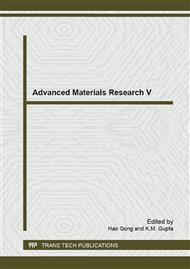p.280
p.285
p.293
p.299
p.305
p.311
p.315
p.320
p.325
Effect of Biogas Volume Flow Rate and Burner Temperature on Moisture Content of Organic Fertilizer in a Rotary Drying Process
Abstract:
Different factors can influence the moisture content of product in an organic fertilizer drying process. In this study, biogas volume flow rate and burner temperature were systematically studied in an effort to ascertain their effect on the moisture content of organic fertilizer grain that had been subjected to rotary drum indirect heating procedures. It was found that these two factors did major effect on the moisture content of organic fertilizer in a rotary drum drying process. Additionally, it was also discovered that acceptable organic fertilizer moisture content occurred when the rotary drum drier utilized both the biogas volume flow rate of 0.058 m3/min. in combination with the drying temperature of 500°C while the percentage of biogas blower and burner operation were reduced by 22.67 % and 9.1%, respectively.
Info:
Periodical:
Pages:
305-310
Citation:
Online since:
May 2015
Authors:
Price:
Сopyright:
© 2015 Trans Tech Publications Ltd. All Rights Reserved
Share:
Citation:


